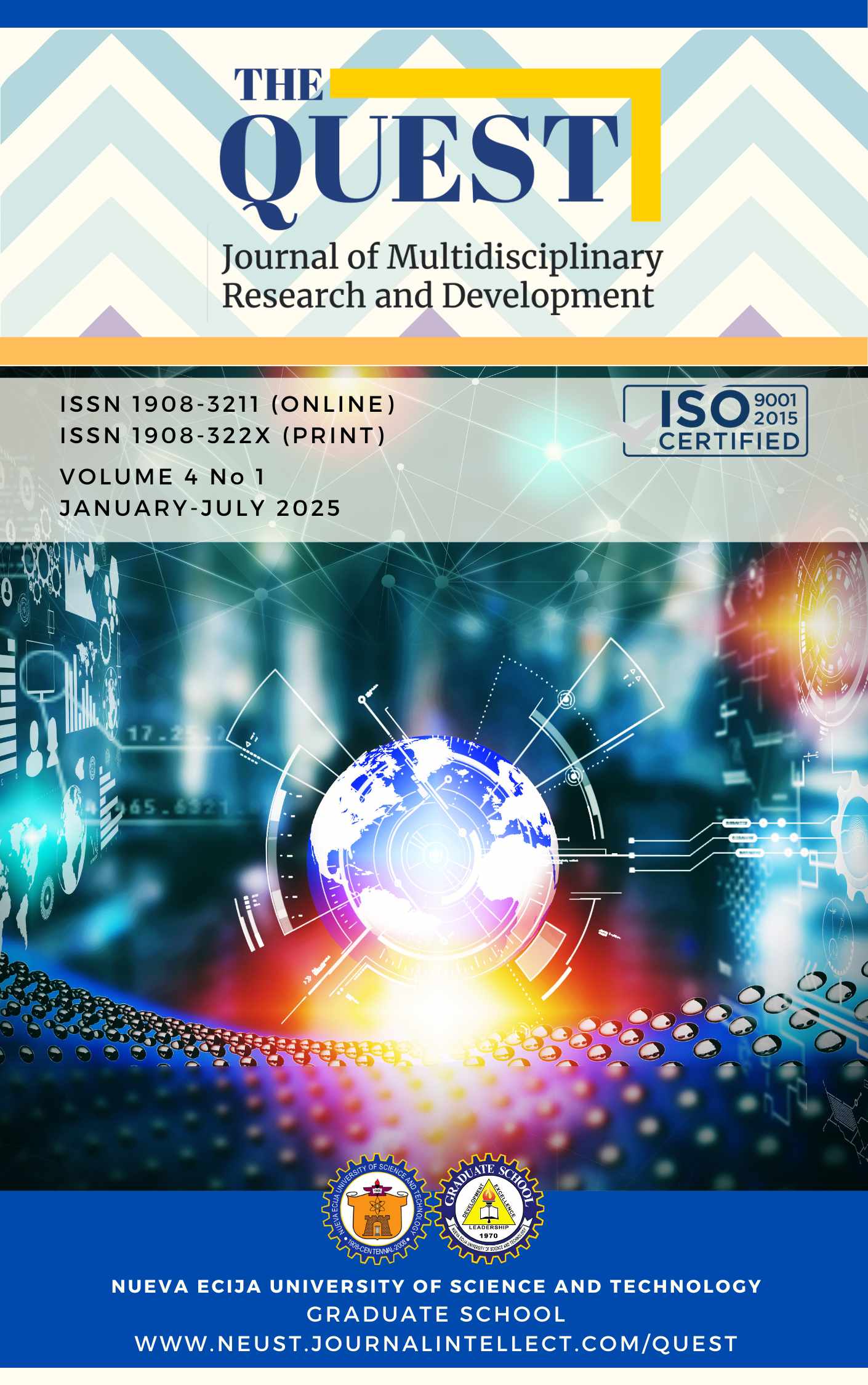Project-Based Learning: A Basis for Enhanced Implementation in Science, Technology, Engineering, and Mathematics Strand

Published 06/30/2025
Keywords
- Enhancement Program
How to Cite
Copyright (c) 2025 The QUEST: Journal of Multidisciplinary Research and Development

This work is licensed under a Creative Commons Attribution-NonCommercial 4.0 International License.
Abstract
This descriptive research aimed to study the factors of Project-Based Learning (PBL) to academic performance of STEM students in terms of learning environment, students' participation, and learning responsibility. One hundred forty-two (142) STEM students from Palayan City National High School were selected using a stratified random sampling to answer the structured questionnaire. The data gathered through the use of Likert Scale surveys were analyzed using weighted mean, and correlation. The findings of the study revealed that research projects are the most common project that the STEM students experienced, while environmental-related projects are the least. Variables such as the learning environment, students' participation, and learning responsibility gained an average weighted-mean of 3.09, 3.22, and 2.86, respectively, which are described as often. Based on the results the profile of the respondents in terms of sex is significantly correlated to students’ participation and learning responsibility, age is significantly correlated to students’ participation and the general average of the learners is significantly correlated to learning environment, students’ participation and learning responsibility. Furthermore, the results of the study revealed that Project-based learning resulted in students to be more active in class discussion resulting in deeper comprehension of lessons, it also enhanced students' communicating skills, discipline, and time management when conducting hands-on activities.
Keywords: Academic performance; Project-Based learning; STEM students
References
- Abu Khurma, O., Al Darayseh, A., & Alramamneh, Y. (2022). A Framework for Incorporating the “Learning How to Learn” Approach in Teaching STEM Education. Education Sciences, 13(1), 1. https://doi.org/10.3390/educsci13010001
- Alexander, C., Knezek, G., Christensen, R., Tyler-Wood, T., & Bull, G. (2014). The Impact of Project-Based Learning on Pre-Service Teachers’ Technology Attitudes and Skills. Journal of Computers in Mathematics and Science Teaching, 33(3), 257–282. https://www.learntechlib.org/p/112337/?fbclid=IwAR15h5tZ63yCZXCBF0M_O28zjHcAe6MpAPpbvG9kCc02DRhtP6q2JV3xpoc
- Almula M.A. (2021). The Effectiveness of Project-Based Learning Approach as a Wayto Engage Students in Learning. https://journals.sagepub.com/doi/10.1177/2158244020938702
- Alrajeh, T. S. (2020). The Value and Use of Project-Based Learning in Teacher Preparation Programs. Cypriot Journal of Educational Sciences, 15(5), 989–1010. https://eric.ed.gov/?id=EJ1274047
- Ayaz, (2015). The Effects of the Constructivist Learning Approach on Student’s Academic Achievement: A Meta-Analysis Study. Turkish Online Journal of Educational Technology - TOJET, 14(4), 143–156. https://eric.ed.gov/?id=EJ1077612
- Bhandari, P. (2021, July 7). Correlational Research | When & How to Use.Scribbr.https://www.scribbr.com/methodology/correlational-research/?fbclid=IwAR3Onj0I2q39iGA1zPhUqcrLFys99oF2IcXrw8nQmF6Gx_XkPELW4PItuH0#:~:text=What%20is%20correlational%20research%3F
- Burgess, A., Roberts, C., Mellis C. (2020). Team Based Learning: Design Facilitation and Participation. https://bmcmededuc.biomedcentral.com/articles/10.1186/s12909-020-02287-y
- Dacumos,L. P. STEM education and the project-based learning: A review article (2023) https://issuu.com/internationalresearch8/docs/utilization_of_project_based_learning_pbl_reso
- Fleetwood, D. (2018, May 3). What is a Likert Scale - Definition, example, characteristics, & advantages. QuestionPro. https://www.questionpro.com/blog/what-is-likert scale/#:~:text=Definition%3A%20A%20Likert%20scale%20is
- France, T. (2015, June). Project-based Learning in a High School Pre-engineering Program: Findings on Student Achievement (RTP, Strand 3). In 2015 ASEE Annual Conference & Exposition (pp. 26-1265). https://peer.asee.org/project-based-learning-in-a-high-school-pre-engineering-program-findings-on-student-achievement-rtp-strand-3
- Israel, J., George, E., & Hein. (1991). Constructivist Learning Theory The Museum and the Needs of People CECA (International Committee of Museum Educators) Conference. https://beta.edtechpolicy.org/AAASGW/Session2/const_inquiry_paper.pdf?fbclid=IwAR3Y0iHy4KnW_6apm8OXfBURGUmvma1dTZQU36NfhLeAiE3ni1q12Y1hb8
- Jumaat, Nurul & Tasir, Zaidatun & Abd halim, Noor & Mohamad Ashari, Zakiah. (2017). Project-Based Learning from Constructivism Point of View. Advanced Science Letters. 23. 7904–7906. 10.1166/asl.2017.9605.https://www.ingentaconnect.com/contentone/asp/asl/2017/00000023/00000008/art00222
- Krajcik, J. S., & Blumenfeld, P. C. (2006). Project-based learning (pp. 317-34). na. https://knilt.arcc.albany.edu/images/4/4d/PBL_Article.pdf
- Kwon, H., Capraro, R. M., & Capraro, M. M. (2021). When I Believe, I Can: Success STEMs from My Perceptions. Canadian Journal of Science, Mathematics and Technology Education, 21(1), 67–85. https://doi.org/10.1007/s42330-020-00132-4
- Lee, M. Y. (2019). Using Project-Based Learning Method As a Way to Engage Students in STEM Education. Research in Mathematical Education. https://www.academia.edu/42139454/Using_Project_Based_Learning_Method_As_a_Way_to_Engage_Students_in_STEM_Education
- Meng, Z. (2023). Meta-Analysis of the Effectiveness of Project-Based Learning Approach on Academic Achievement on Higher Education Worldwide.https://repository.usfca.edu/cgi/viewcontent.cgi?article=1661&context=diss
- Nugroho, K.Y. (2017). Constructivist Learning Paradigm as the Basis on Learning Model Development.
- https://www.semanticscholar.org/paper/Constructivist-Learning-Paradigm-as-the-Basis-on-Nugroho/d9c9491cea23327598fa2d099179580f35f42ede?fbclid=IwAR1bPcWhvTF2s5wibbHaPaJ9LkhEwHKP48PEZZRMV3UJ1WmCFlYjdUAGBSc
- Purwaningsih, E., Sari, A. M., Yuliati, L., Masjkur, K., Kurniawan, B. R., & Zahiri, M. A. (2020, March). Improving the problem-solving skills through the development of teaching materials with STEM-PjBL (science, technology, engineering, and mathematics-project based learning) model integrated with TPACK (technological pedagogical content knowledge). In Journal of Physics: Conference Series (Vol. 1481, No. 1, p. 012133). IOP Publishing. https://iopscience.iop.org/article/10.1088/1742-6596/1481/1/012133/meta?fbclid=IwAR3y5cWasmyDrfThdjkGRKEvFPiSQNTaen5YVXcGQqO_MmJFvPv4_uwhCqA
- Reyes, Renee Rose, Project-Based Learning in Science: Effects on Students' Science Process and 21st-Century Skills (April 28, 2023). Renee Rose Corbano-Reyes (2023). Project-Based Learning in Science: Effects on Students’ Science Process and 21st - Century Skills, Psychology and Education: A Multidisciplinary Journal, 10(9): 1010-1020, Available at SSRN: https://ssrn.com/abstract=4528740
- Santoso A.M, Primandiri P.R, Zubaidah S, Amin M. (2021). The development of students' worksheets using project based learning (PjBL) in improving higher order thinking skills (HOTs) and time management skills of students. https://iopscience.iop.org/article/10.1088/1742-6596/1806/1/012173/meta
- Satter, S. (2022, December 11). Structured Questionnaire: Definition, Types + Pros & Cons. QuestionPro. https://www.questionpro.com/blog/structured-questionnaire/
- Sayary, E., & Adel, A. M. (2014). The Effectiveness of Problem-Based Learning Strategy in STEM Education for Enhancing Students’ 21st Century-Skills.Bspace.buid.ac.ae. https://bspace.buid.ac.ae/items/2d67b80a-30d2-4a70-a8f8-aa18ca8b29d6?fbclid=IwAR3ITk0oTRF-0UEvh25reULSSmsRihRgIX15NZJaaRjQxjQRIH4wFyDs9gI
- Sidman-Taveau, R., & Milner-Bolotin, M. (2001). Constructivist Inspiration: A Project-Based Model for L2 Learning in Virtual Worlds. In ERIC (Vol. 6).
- https://eric.ed.gov/?id=ED464498
- Siew, N. M., Amir, N., & Chong, C. L. (2015). The perceptions of pre-service and in-service teachers regarding a project-based STEM approach to teaching science. SpringerPlus, 4(1). https://doi.org/10.1186/2193-1801-4-8
- Thomas, L. (2020, September 18). How to use stratified sampling. Scribbr. https://www.scribbr.com/methodology/stratified-sampling/#:~:text=In%20stratified%20sampling%2C%20researchers%20divide
- The Ripple Effect: Exploring How a Joint Science Specialist/TOSA Can Change Classroom Teachers’ Instructional Practices through Project-Based Learning - ProQuest. (n.d.). Retrieved November 25, 2023, from https://www.proquest.com/openview/71495f3c6d07ce7a13e6dfcbaee22cb2/1?pq-origsite=gscholar&cbl=18750
- Topping K. Peer Assessment: Learning by Judging and Discussing the Work of Other Learners.https://discovery.dundee.ac.uk/en/publications/peer-assessment-learning-by-judging-and-discussing-the-work-of-ot
- Wurdinger, S. D. (2016). The Power of Project-Based Learning: Helping Students Develop Important Life Skills. In Google Books. Rowman & Littlefield. https://books.google.com.ph/books?hl=en&lr=&id=B2u2DAAAQBAJ&oi=fnd&pg=PR5&ots=QELvmViRcv&sig=0JiV9IaojlYyV7McDoAMbMaIoqw&redir_esc=y#v=onepage&q&f=false
- https://www.researchgate.net/publication/366390022_Simple_Random_Sampling
- https://www.bu.edu/ctl/ctl_resource/project-based-learning-teaching-guide.

